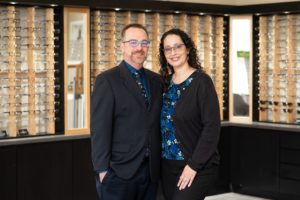sponsored content
March 15, 2022
By Nathan Bonilla-Warford, OD, FAAO, FCOVD, FAAMOC, and Cristina Bonilla-Warford, MS, LDO
By having staff understand our myopia program, our patients feel much more confident in our services. It creates a smooth process for patients and makes things easier for the entire team.

At Bright Eyes Family Vision Care, training staff members on myopia management is important for patients and the practice.
As our myopia control program has grown, we have learned that staff training is essential to our practice’s success. Having a protocol in place allows our program to be consistent and efficient, and the majority of these training efforts have been developed through trial and error and have evolved over time. To ensure that our training methods were as comprehensive as possible, we have pulled ideas and resources from attending Vision By Design and by reading Review of Myopia Management.
When we first started offering myopia control, our optometric assistant coordinated with the doctor on all of our myopia patients’ care because there weren’t that many of them. But as the number of myopia patients and the staff grew, we needed more help at different points in the process.
Although we believe strongly that every staff member should have some degree of myopia training, different staff members have different responsibilities in the myopia program, so we have developed specific training for these different roles. All new staff members undergo a lecture from the doctor on the clinical aspects of myopia and myopia control, and the practice manager covers the program details. Because patients may encounter and talk to any staff member, every new hire must understand:
- what myopia is
- why myopia management is important
- the treatment options for myopia
- the price of the myopia control program
- how to direct patients so they can get more detailed information
What Does Training Look Like?
We grouped all of our employees into teams, including team leaders, all with distinct responsibilities, to help make the myopia control program run smoother. Each team is responsible for different tasks, and they interact with myopia patients and their parents at different points throughout the process. By having teams, tasks are more streamlined, and everyone is clear on what their roles are on a daily basis.
In general, the doctor, practice manager, and Myopia Coordinator will set myopia control policies and procedures. These will then be drafted into documents appropriate for different teams. The Team Leads will then work directly with the employees on their team to administer formal training. While the documents serve as a tangible resource for new employees, they also have the opportunity to work closely with the Team Leads to learn the ins and outs of what is expected of them in their roles.
For example, when a new staff member is onboarded onto the clinical team, they will receive one-on-one training on how to operate the diagnostic equipment and how to conduct testing with patients. They will also receive a guide that spells out which tests are needed for which encounter types to help them get acquainted with the clinical instruments and protocols.
Similarly, documents are created for the optical team about the precise costs of the myopia program, what is included, and the procedures needed for each of the myopia control modalities. The Myopia Coordinator works with the Optical Team Lead to ensure that all opticians are familiar with these so that they are able to take time to explain to parents the economic and time commitments of the program, even though they do not participate in the direct care — other than ordering, preparing, and dispensing contact lenses and glasses.
Job Responsibilities Impact Training
Members of our clinical team assist the doctor with direct patient care. To increase efficiency, much of the data collection — such as axial length, autorefraction, corneal topography, and retinal photography — is delegated to staff members. Clinical team members are appropriately trained in collecting clinical data using various diagnostic instruments, including how the instruments work, how to conduct testing with patients, and how to troubleshoot when things don’t go smoothly. Additionally, they are trained on how to appropriately document the findings within the patient chart. Clinical team members represent the doctor, so they must be highly trained in communication skills to instill confidence in patients and their parents.
In addition to ongoing training between clinical team members and the clinical team leader, a monthly clinical team meeting allows for questions and answers and additional training as needed.
We have one staff person designated as the Myopia Coordinator on the optical team. The Myopia Coordinator and the assistant manager are responsible for scheduling myopia patients, preparing myopia paperwork, communicating with patients, and training patients and their parents on the different treatment modalities. The office manager assists with these tasks if one of the other two is unavailable. Staff designated as primary contacts for our myopia program must be organized, good communicators, and understand the value of myopia management for our patients. In fact, both our Myopia Coordinator and assistant manager have children in our myopia management program, so they are great advocates on a personal level as well.
We train the rest of the optical team about ordering soft multifocal contact lenses and orthokeratology lenses and scheduling follow-up visits. They are trained to help patients, and they also know when to ask the Myopia Coordinator for assistance with complicated situations. A weekly optical meeting reinforces that all of these tasks are consistently performed.
By having staff understand our myopia program, our patients feel much more confident in our services. It creates a smooth process for patients and makes things easier for the entire team.
 |
Nathan Bonilla-Warford, OD, FAAO, FCOVD, FIAOMC, graduated from Illinois College of Optometry in 2004 and completed his Pediatric and Binocular Vision Residency there in 2005. Cristina Bonilla-Warford, MS, LDO, has served as Practice Manager, optician, and vision therapist. They own Bright Eyes Family Vision Care and Bright Eyes Kids, a practice explicitly dedicated to children’s vision care, both located in Tampa, Fla.
This article is sponsored by Eyes on Eyecare. |













